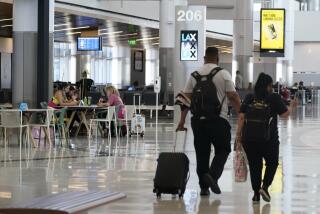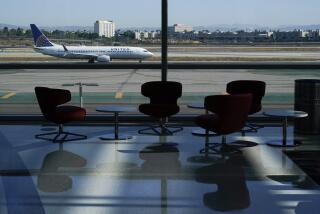New John Wayne Air Terminal Cost in Mid-Range, Study Says
- Share via
Despite months of controversy about cost overruns and design changes, John Wayne Airport’s new $50-million passenger terminal is neither cheap nor expensive when compared to similar projects nationally, according to an informal Times survey.
A Times survey of 21 projects throughout the United States showed a wide price range, from $59 per square foot of new terminal space in Fargo, N.D., to $357 per square foot at Chicago’s splashy new United Airlines complex.
John Wayne’s new terminal is running about $148 per square foot.
Plagued by controversy from the start, the terminal is part of a $310-million expansion program that also includes new garages, roads, bridges and airfield improvements-- Orange County’s biggest public works project ever. The project has been beset by design errors, cost overruns, and mistakes in price estimates.
But with the topping off of the ironwork last month, the new terminal appears to be progressing more smoothly.
14 Weeks Behind Schedule
The Orange County Grand Jury, in one of its periodic progress reports, last week warned that the project is 14 weeks behind schedule. But officials still predict that the new structure will be occupied by April 1, although some interior walls may not be painted by then and some gates may not be open to aircraft.
To be sure, issues remain, such as the siting for a million-gallon, above-ground fuel storage facility, business disputes between prime contractor Taylor Woodrow California Construction Ltd. and subcontractors, and difficulty in reaching the goal of 10% participation by firms owned by women and minorities.
But according to Project Manager Richard Begley: “The worst is behind us. You will see enormous progress from this point forward.”
Begley has contended that the problems at John Wayne hardly stand alone.
Some examples found in The Times survey:
- In San Jose, a soils engineering firm failed to discover an underground stream at the site of the city’s new passenger terminal, causing delays for pumping. Delivery of tons of granite from Italy fell behind schedule. And an airport spokesman said the city is probably going to seek reimbursement from the architect for some errors and omissions discovered in blueprints.
- In Nashville, Tenn., where a new $105-million facility nearly twice the size of the new John Wayne terminal was completed in only 21 months, two subcontractors went broke in mid-project. The head of the agency in charge of Nashville’s airport expansion was embroiled in a controversy over his ownership of land near the airport. A fish on the endangered species list was found in a stream near the new terminal site, and airport neighbors have sued to block construction of a new runway that environmental impact documents previously failed to mention.
- In Albuquerque, N.M., where a project doubling the size of the airport’s existing terminal will be completed later this month, the sandy soil beneath the building shifted. The roof leaked on airline employees. The heating and cooling systems failed.
- In Chicago, work began on some sections of the $500-million United Airlines terminal before others had been designed. The new terrazzo floor cracked. Construction workers went on strike. And the multimillion-dollar glass roof, which was reflecting blinding streams of light into the eyes of air traffic controllers, had to be etched with acid after it was already in place.
Despite such problems, officials at each of these airports used phrases like “running smoothly” to describe their terminal-construction projects.
Making Up Time
Problems occur, airport and airline industry officials say, because airport projects are large, complex, and rely on armies of workers who have trouble communicating. Some officials, such San Jose airport spokesman Steve Grossman, are fatalistic. “I believe that on almost any project you’re going to find some of these things,” he said. “But the bottom line is that, here at least, they have not delayed the expected completion date because you make up time as you go along.”
The frenzied pace of airport building is part of a national boom in terminal construction and remodeling caused by intense competition among airlines for market share and a need to replace inadequate, worn-out facilities that were built to accommodate first-generation jetliners 30 years ago.
Denver, for example, plans to build a new airport at a cost of more than $2 billion. Chicago is going through a $2-billion airport-improvement program that includes the recently opened, $500-million United Airlines terminal. National Airport in Washington and its sister airfield, Dulles International Airport, are jointly planning $1.2 billion in improvements. Dallas-Ft. Worth and JFK in New York are each planning improvements totaling more than $1 billion. Orlando, Fla., is in the midst of a $430-million expansion program, and San Francisco anticipates spending at least $300 million.
And at Los Angeles International Airport, which was remodeled for the 1984 Summer Olympics, Delta Airlines last year spent more than $85 million reconstructing its terminal, and several airlines are spending an additional $200 million combined on other terminal remodeling projects. The Federal Aviation Administration reports that annual requests for airport development grants have jumped from $4.5 billion to $7.5 billion just in the past three years.
Construction Boom Needed
“We need this construction boom,” says Tom Browne, manager for airport policy and administration at the Air Transport Assn., the industry group that represents air carriers. “Most everything (new) that’s going in is capacity related. . . . There are more passengers and more planes. And some of the capacity gains involve replacing the old with the new.”
Air travel demand is expected to reach 750 million passenger boardings per year by 2001, compared to 450 million projected for 1989.
Most airport terminal construction or remodeling is financed with revenue bonds, which are repaid with airline landing fees and rents collected from food vendors and car-rental agencies. When leased airport space goes up in price because of remodeling or new construction, concessionaires charge the public accordingly.
A Continental Airlines official, for example, recently stated that if Denver builds a new, $2.3-billion airport, it could add $36 to ticket prices for passengers going to or from that facility.
One industry official, who spoke on condition of anonymity, said the new passenger terminal at John Wayne Airport could add $5 to $7 to the airlines’ cost for each boarding passenger.
More to Read
Sign up for Essential California
The most important California stories and recommendations in your inbox every morning.
You may occasionally receive promotional content from the Los Angeles Times.













